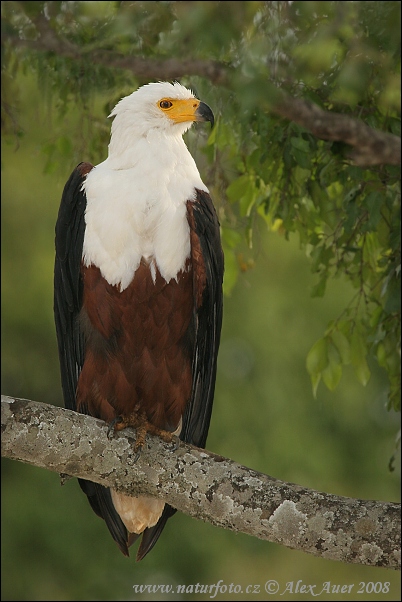 The African Fish Eagle (Haliaeetus vocifer) or – to distinguish it from the true fish eagles (Ichthyophaga), the African Sea Eagle – is a large species of eagle that is found throughout sub-Saharan Africa wherever large bodies of open water occur that have an abundant food supply. It is the national bird of Zimbabwe and Zambia and South Sudan.This species may resemble the Bald Eagle in appearance; though related, each species occurs on different continents, with the Bald Eagle being resident in North America.As a result of its large range, it is known in many languages. Examples of names include: Visarend in Afrikaans; Aigle Pêcheur in French;Hungwe in Shona, and Inkwazi in Zulu.
The African Fish Eagle (Haliaeetus vocifer) or – to distinguish it from the true fish eagles (Ichthyophaga), the African Sea Eagle – is a large species of eagle that is found throughout sub-Saharan Africa wherever large bodies of open water occur that have an abundant food supply. It is the national bird of Zimbabwe and Zambia and South Sudan.This species may resemble the Bald Eagle in appearance; though related, each species occurs on different continents, with the Bald Eagle being resident in North America.As a result of its large range, it is known in many languages. Examples of names include: Visarend in Afrikaans; Aigle Pêcheur in French;Hungwe in Shona, and Inkwazi in Zulu. |
| THIS IS A PAINTING OF AN AFRICAN FISH EAGLE ON FLIGHT |
 |
| AFRICAN FISH EAGLE FIGHTING WITH TWO OSPREYS |
 |
| THIS IS THE PICTURE OF AN AFRICAN FISH EAGLE FEEDING IT'S BABY! |
Breeding season for African Fish Eagles is during the dry season, when water levels are low. African Fish Eagles are believed to be monogamous - in other words, they mate for life. Pairs will often maintain two or more nests, which they will frequently re-use. Because nests are re-used and built upon over the years the nests can grow to be quite large, some reaching 2m (six feet) across and 1.2 m (4 feet) deep. The nests are placed in a large tree and built mostly of sticks and other pieces of wood.The female lays 1 to 3 eggs, which are primarily white with a few reddish speckles. Incubation is mostly done by the female, but the male will incubate when the female leaves to hunt. Incubation lasts for 42 to 45 days before the chicks hatch. The eggs will often hatch a few days apart, and the eldest chick will usually kill any younger chicks; this tactic is known as siblicide and is also found in other birds of prey. Fledging lasts for 70 to 75 days, and after about 8 weeks the chick is capable of feeding itself and will usually begin to venture outside of the nest 2 weeks later.The African Fish Eagle feeds mainly on fish, which, upon spotting a potential prey item from a perch in a tree, it will swoop down upon and snatch the prey from the water with its large clawed talons. The eagle will then fly back to its perch to eat its catch.
No comments:
Post a Comment